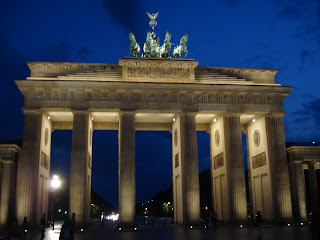Just a few days before going to Germany, Angela Merkel announced that Germany would abolish all nuclear energy production by the year 2022, making it the first country in the western world to radically establish a policy against nuclear energy. As you can imagine this was fresh in the minds of German citizens and often the topic of discussion with our host families. The general consensus is that it is a reactive policy from the earthquake disaster of Japan, and while it is ideologically sound, it is not realistic with the deadlines imposed, and some will go as far as to say that the overall global environmental impact is negative, rather than positive, because the materials used in creating windmills are produced from toxic materials. As we drive in the plains of the Eifel region, at altitude of 600 m, we notice that the landscape is no longer what it used to be. There are windmills every other 100 yards or so in the horizon. It does not shock me personally but people living in these lands already feel that nature is compromised. Most northern states of Germany are poised to have even more windmills installed. It is a likely that in order to replace nuclear energy with solar and wind, it will have to come from the north of Germany, particularly from the North Sea, which for some means obstructing the landscape of the seashores, and requiring a massive operation to wire the energy back to the homeland. Whether it is the right decision or not, one thing that is noticeable in every house we visited, is the sense of conservation of energy and care for the environment. Something that we in the United States are slowly embracing but have yet to learn from our friends in overseas. Here are four basic observations that demonstrate sustainable living in Germany:
Solar panels built on house roof top are quite common in rural areas, providing energy not for the house in which it is built, but for the state. Indeed, energy produced on private houses is sold to the German government for 49 cents a kilowatt, but the family uses the city s utilities for its daily needs and pays 29 cents a kilowatt, generating revenues on their long term investment. Unfortunately, while solar panels provide clean energy, they are still not profitable. Their initial cost ranges from 24, 000 euros and up, making it difficult to rip the cost benefit until a few decades. The government incentives for solar energy have been cut in the past years due to the economy, thus reducing the price of which it buys it back from consumers. Solar energy is a much less attractive investment than it was before. But many German households still use solar panels, not to rip off the benefits of the states, but because they believe it is morally the right thing for our planet. This in turns means that only wealthy families are able to afford it.
In bathrooms, toilet flushes are set on two levels, small and large, or have at least a flush and stop mechanism, which determines the amount of water to dispose to flush the toilet. This saves considerable volume of water, hence reducing the water expenses and the energy needed to treat water in the plants. Very simple yet practical lesson for anyone. In the United States, it is now possible to buy such a device for abut $30, but we have yet to see it in new houses built. This little investment can make a bit of difference as we can predict the cost of water to rise.
Lights; energy is conserved through the minimalization of light consumption. Houses are built with large windows, and most commercial or public buildings have light sensors. There are no switches when entering bathrooms in an office, it comes up automatically and goes off automatically. No need to leave lights on if it is not used or needed. This can also be the case in some houses, stores, garages, and even historical sites. Lights are turned off if not needed. This is another simple technique to save on energy, but its clear that German companies and households take it very seriously.
Recycling is not only mandatory in Germany, it is a way of living. Every household sorts out their litter between bins for paper, glass and plastic, and food. It is then picked up by the city or dropped in containers placed in most villages or neighbourhoods. This is not that unusual, but what’s even more fascinating is the value of plastic and glass bottles to incentivize consumers to return them to a recycling depot. A bottle of coke for example is worth 50cents which is paid upfront in the price of the drink, but can be redeemed after its consumption. The other day as I was cleaning our van, I found three empty water bottles and wanted to through them away in a special trash bin from the streets. I was quickly stopped by one of the host family members who asked me to save them to get money back. They each returned 25 cents. Therefore when you buy a bottle of soda or water, whether the bottle is in plastic or glass, small or large, you can be almost sure it has been used over and over.
While much can be debated about the real impact of these consumer choices, Germany has a clear competitive advantage over other countries; it has successfully created a culture whereas individuals, companies, and governments have instilled a sense of respect for the environment in their daily lives. And since the priorities of developed countries are set on developing green energy, Germany may lead us in thinking, creating, and using tools and resources that will help all of us be conscientious of the impact of our choices.


















































